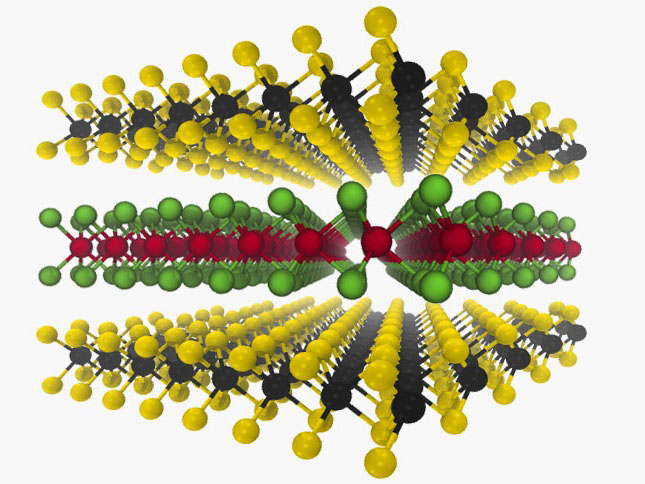Researching the LED Wallpaper of the Future

Graphical representation of stacks of atomic thin crystals Frank Jahnke
We live in a world of displays whose size and color-brilliance are constantly increasing. The further development of the light bulb is simple: It is increasingly being replaced by LEDs, in which so-called semiconductors produce the light.
However, the uses of displays are limited because conventional semiconductor materials tend to be inflexible and rigid. Although it is possible to produce displays with organic light-emitting diodes (OLEDs), their lifetime and light output are lower than their inorganic relatives.
Now, new materials are coming on stream which are extremely thin and produce very intense light –and are at the same time surprisingly easy to manufacture: Using conventional adhesive tape it is even possible to strip individual atomic layers of special crystals in the laboratory.
Particularly suitable for this purpose are the so-called “van der Waals” crystals. A key idea here is the principle of the “Lego modular system”. The functionalities of luminous and electrically conductive, atomically thin materials are combined by stacking them directly on top of one another.
Innovative material allows use in sensors and solar cells
The materials produced in this way exhibit enormous mechanical stability. Not only do they efficiently emit light, they can also absorb light and turn it into electricity. This has already resulted in initial applications in highly sensitive sensors, and their use in flexible solar panels also seems to be a next step. This feature is particularly interesting in view of the growing demand for renewable energy.
Dancing game of particles explored
Light in a certain range of the color spectrum is generated in semiconductors by the emission of positive and negative electric charges. Owing to their different polarities, the opposite charges attract each other and can combine to form new composite particles, so-called excitons, with altered properties. In the course of their basic research on new materials, the physics team at the University of Bremen has developed a method with which these composite particles can be visualized and studied.
The scientists have been able to analyze how the occurrence of composite particles depends on the number of charges that can be controlled externally with a light emitting diode. “The unequal charges show a behavior very similar to that of dancers on a differently populated dance floor. If the density is low, there are very few dancers on the floor and it’s difficult to find a partner – so everyone dances on their own. On a well-filled dance floor, however, couples form and dance together undisturbed.
Eventually, though, an overcrowded dance floor leads to the couples colliding a lot, so that they separate and everyone dances alone again,” is how the early-career researcher Dr. Alexander Steinhoff explains his research to a layperson.
“We were able to show that the composite particles can be visualized by means of photoelectron spectroscopy.” He goes on to explain, “By so doing, a high-energy light particle is irradiated. The composite particle is crushed and its constituents are released from the semiconductor and lock onto the structure of the composite particle.”
New method brings structure into the dance
The authors suggest in the Nature article to use these findings. The relationship between free and paired charges directly affects the optical and electronic properties of the material. It can be controlled by targeted structuring of the environment to which atomic thin materials react sensitively. The scientists hereby make an important contribution to handling the “Lego-like modular system” and the production of ultra-thin opto-electronic components with tailor-made properties.
The work was funded by the German Research Foundation (DFG) in the frame of the graduate school “Quantum Mechanical Materials Modeling” at the University of Bremen. The article “Exciton fission in monolayer transition metal dichalcogenide semiconductors” can be read under this link: www.nature.com/articles/s41467-017-01298-6 (DOI number: 10.1038 / s41467-017-01298-6).
Attention editors: You will find images under:
https://seafile.zfn.unibremen.de/d/2bd6be7b3b1a4f52a4b7/
If you would like more information on this topic, feel free to contact:
Prof. Dr. Frank Jahnke
University of Bremen
Institute of Theoretical Physics
Phone: +49 421 218-62050
Email: jahnke@itp.uni-bremen.de
Media Contact
More Information:
http://www.uni-bremen.deAll latest news from the category: Physics and Astronomy
This area deals with the fundamental laws and building blocks of nature and how they interact, the properties and the behavior of matter, and research into space and time and their structures.
innovations-report provides in-depth reports and articles on subjects such as astrophysics, laser technologies, nuclear, quantum, particle and solid-state physics, nanotechnologies, planetary research and findings (Mars, Venus) and developments related to the Hubble Telescope.
Newest articles

A ‘language’ for ML models to predict nanopore properties
A large number of 2D materials like graphene can have nanopores – small holes formed by missing atoms through which foreign substances can pass. The properties of these nanopores dictate many…

Clinically validated, wearable ultrasound patch
… for continuous blood pressure monitoring. A team of researchers at the University of California San Diego has developed a new and improved wearable ultrasound patch for continuous and noninvasive…

A new puzzle piece for string theory research
Dr. Ksenia Fedosova from the Cluster of Excellence Mathematics Münster, along with an international research team, has proven a conjecture in string theory that physicists had proposed regarding certain equations….



